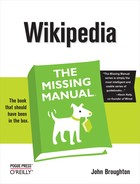At the top of every page in Wikipedia, you can expect to see six tabs (seven tabs if it’s a talk page). These tabs let you switch between the main article page, the talk (discussion) page, the page history, and so on.
Note
Pages with the “Special:” prefix, such as the Special:Watchlist page, don’t have tabs. Special pages, which Wikipedia’s software automatically generates, don’t have a history, and you can’t edit them. Think of them as one-time reports.
The name of the leftmost tab indicates the namespace you’re in. For example, if you’re looking at an article, it says “article”. If you’re looking at a WikiProject page, it says “project page”. (All WikiProject pages have the have the prefix “Wikipedia:”.) if you’re looking at a Category page (Chapter 17), it says “category”, and so on.
Note
You may hear other editors use the term projectspace. That just means all WikiProject pages. If the leftmost tab says, “project page”, you’re in projectspace. If you want to get the terminology right, articles are in mainspace, not “articlespace” (though if you slip up and use the latter word, other editors will understand what you’re talking about).
Displays the talk page associated with an article, Wikipedia instructional page, category, or whatever. The tab probably should say “talk page”, since that’s what everyone calls them. Maybe someday there’ll be consensus to change this tab to “talk”. (See Posting Conventions for details on how to properly use talk pages.)
Clicking this tab takes you to the page’s editing screen (???). The vast majority of Wikipedia pages have an “edit this page” tab, and you’re free to do so.
If you see “view source” rather than “edit this page”, the page is protected against editing. If you click that tab, you see the page’s wikicode (with a shaded background, not the usual white background). You can see how the page was created, even though you can’t edit it, and you can even copy the wikitext.
The “new section” tab is found only on talk pages and a few project pages, such as noticeboards and the Help desk. When you click the tab, Wikipedia starts a new section at the bottom of a page. As discussed on Starting a new section, use this tab when starting a discussion of a new topic (rather than clicking “edit this page” or editing the existing bottom section, and adding a new heading).
Shows all edits of the page, going back to the first edit that created the page. (In Wikipedia, an edit is simply the difference between one version of a page and the previous version.) You can also use this page to see all previous versions of the page, with the most recent listed at the top, going back to the very first version. Chapter 5 explains in detail how to interpret the history pages of articles.
Two things to keep in mind when you’re looking at a history page:
As a regular editor, you don’t see any versions of a page that an administrator (Why Wikipedia Keeps a Record of Everything) or Oversight (???) deleted. Pages are very rarely deleted in this way—it only happens in cases such as libel, copyright violations, or violations of personal privacy—but Wikipedia takes such problems very seriously.
The “edit this page”, “move”, and “watch” tabs don’t apply to history pages—you can’t edit them, rename them, or put them on your watchlist. If you click one of these three tabs, you’re really acting on the page whose history you were looking at, not the history page itself. That’s why when you select the “history” tab, the “article” or “discussion” tab is selected as well, so you can tell what the history page pertains to. Also, that selected tab shows you what page is affected when you click, say, the “move” tab.
Starts the process of renaming a page. Renaming is extensively discussed in Chapter 16.
If you don’t see a “move” tab, the page is protected against being renamed. For example, you can’t rename Wikipedia’s Main Page. Move protection normally happens when pages have been vandalized by renaming, or where there’s been a big controversy over the name.
Watching a page means adding it to the list of pages in your Special:Watchlist report. Chapter 6 explains how to monitor pages using your watchlist.
